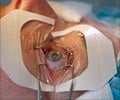- Computational models offer 3D insights for optimal intraocular lens selection post-LASIK
- Technology enables patients to visualize lens options, enhancing surgical planning
- Researchers extend their techniques to study presbyopia and myopia
AI helps bring clarity to LASIK patients facing cataract surgery
Go to source).
AI-Based Lens Selection After Lasik Surgery
A study published in the Journal of Cataracts & Refractive Surgery by researchers from the University of Rochester focused on constructing computational models of eyes post-LASIK surgery.New Strategies Offer More Clarity in Lens Selection
Marcos, a co-author of the study, explained, "Currently the only pre-operative data used to select the lens is essentially the length and curvature of the cornea. This new technology allows us to reconstruct the eye in three dimensions, providing us with the entire topography of the cornea and crystalline lens, where the intraocular lens is implanted. When you have all this three-dimensional information, you’re in a much better position to select the lens that will produce the best image at the retinal plane."The researchers, in collaboration with institutions including the Center for Visual Science, Flaum Eye Institute, and Goergen Institute for Data Science at Rochester, are conducting a broader study to quantitatively assess eye images in three dimensions using their developed tools for optical coherence tomography.
They employ machine-learning algorithms to identify correlations between pre- and post-operative data, offering parameters that can enhance the final results.
Furthermore, the team has created technology that enables patients to visualize the appearance of various lens options for themselves.
Marcos pointed out, "What we see is not strictly the image that is projected on the retina. There is all the visual processing and perception that comes in. When surgeons are planning the surgery, it is very difficult for them to convey to the patients how they are going to see. A computational, personalized eye model tells which lens is the best fit for the patient’s eye anatomy, but patients want to see for themselves."
This approach allows Marcos and her team to conduct essential experiments and collaborate with industry partners to test new products. Additionally, a commercial headset version of the equipment, known as SimVis Gekko, has been developed, enabling patients to experience their surroundings as if they had undergone surgery.
Reference:
- AI helps bring clarity to LASIK patients facing cataract surgery - (https://www.rochester.edu/newscenter/ai-helps-bring-clarity-to-lasik-patients-facing-cataract-surgery-567672/)
Source-Medindia
















